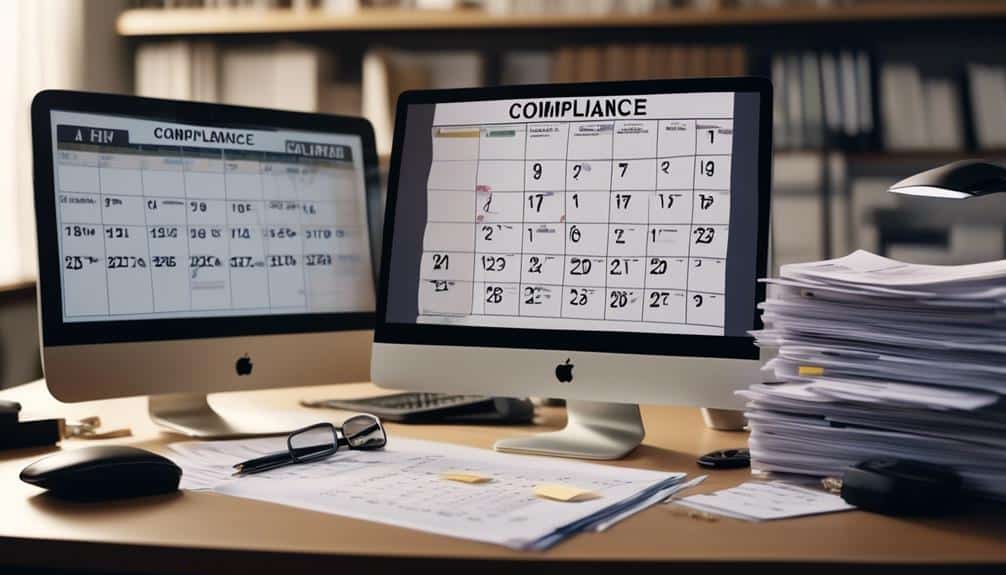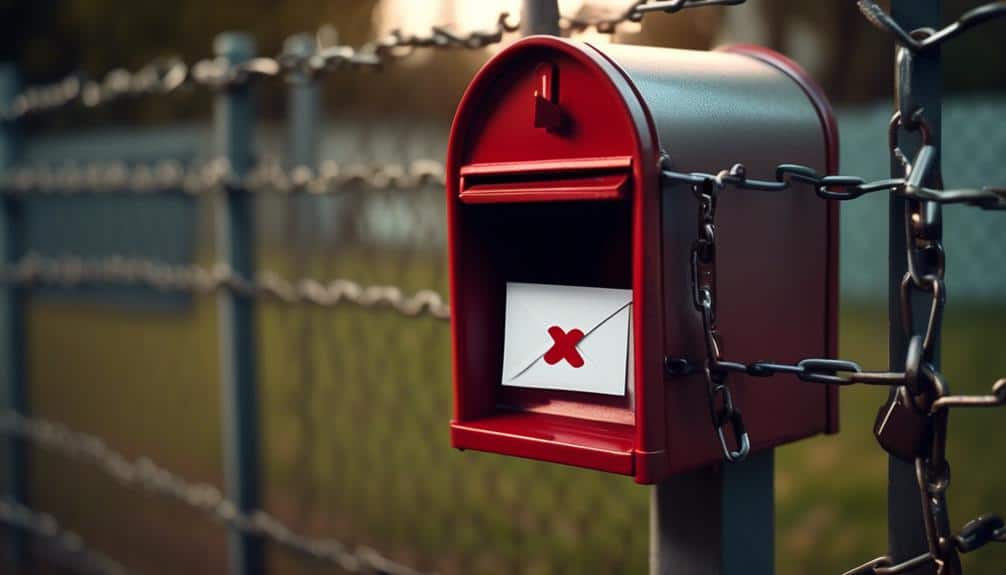Don't Risk It: Key Strategies for Meeting Email Compliance Standards
Don't delay, dive into the world of email compliance standards and discover the key strategies that will safeguard your organization from potential risks and penalties.
In today's digital landscape, where email communication plays a pivotal role in business operations, it is imperative to ensure that your company adheres to industry regulations and maintains the highest level of data security.
But how can you navigate this complex terrain and protect your organization's sensitive information?
Read on to uncover the essential strategies that will help you stay on top of email compliance requirements and safeguard your business from potential pitfalls.
Key Takeaways
- Understanding industry regulations is crucial for organizations to protect sensitive information, ensure data privacy, and prevent unauthorized access.
- Implementing strong email security measures, such as encryption and robust data protection measures, can safeguard sensitive information and minimize the risk of security breaches.
- Educating employees on email compliance best practices, including identifying phishing attempts and creating strong passwords, is essential to ensure adherence to email compliance standards.
- Establishing clear policies and procedures, conducting regular policy evaluations, and implementing a compliance reporting system are important for maintaining email compliance and reducing the risk of policy violations.
Understand Industry Regulations

To ensure compliance with email regulations, it's crucial for you to have a solid understanding of the industry regulations that apply to your organization. An industry regulations overview will help you navigate the complex landscape and avoid compliance challenges. These regulations are put in place to protect sensitive information, ensure data privacy, and prevent unauthorized access to confidential data. By familiarizing yourself with these regulations, you can proactively implement appropriate measures to safeguard your organization's email communications.
Industry regulations vary depending on the sector you operate in. For example, if you work in healthcare, you need to adhere to HIPAA regulations, which govern the handling of patient health information. On the other hand, financial institutions must comply with regulations like the Gramm-Leach-Bliley Act, which safeguards consumer financial information. Understanding these specific regulations is essential to avoid hefty fines and reputational damage.
Compliance challenges arise when organizations fail to grasp the intricacies of industry regulations. This can result in accidental violations, data breaches, and legal consequences. Taking the time to educate yourself on the regulations that govern your industry will enable you to create effective policies and procedures that align with the requirements.
Implement Strong Email Security Measures
Having a solid understanding of industry regulations is crucial in order to implement strong email security measures for your organization. By following these key strategies, you can ensure that your emails are protected and compliant with data protection regulations:
- Email encryption: Implementing email encryption is essential for safeguarding sensitive information. Encrypting emails ensures that only authorized recipients can access and read the contents, thus minimizing the risk of data breaches or unauthorized access.
- Data protection: Protecting the data within emails is vital for compliance with industry regulations. Implementing robust data protection measures, such as firewalls, antivirus software, and intrusion detection systems, can help prevent unauthorized access or data leaks.
- User awareness training: Educating your employees about email security best practices is crucial. Conduct regular training sessions to raise awareness about phishing attacks, social engineering, and other common email threats. By empowering your employees with knowledge, you can minimize the risk of human error leading to security breaches.
Educate Employees on Email Compliance Best Practices

Ensure your employees understand and adhere to email compliance best practices to protect sensitive information and maintain regulatory requirements. Employee training is crucial in ensuring that your staff is well-informed about the proper handling of emails and the security measures that need to be implemented. By educating your employees on email compliance best practices, you can minimize the risk of data breaches and non-compliance.
Start by providing comprehensive training sessions that cover the basics of email security, such as identifying phishing attempts, creating strong passwords, and recognizing suspicious email attachments. Make sure to emphasize the importance of following company policies and procedures when it comes to email usage.
Regularly update your training materials to reflect the latest email compliance standards and industry regulations. This will help your employees stay up to date with the evolving landscape of email security. Additionally, consider conducting simulated phishing exercises to assess employee knowledge and identify areas that need improvement.
Furthermore, establish clear guidelines on the appropriate use of personal email accounts for business purposes. Encourage employees to use company-provided email accounts and discourage the use of personal email for work-related communications to minimize the risk of sensitive information being compromised.
Establish Clear Policies and Procedures
To establish clear policies and procedures for email compliance, you need effective policy implementation strategies that outline expectations and guidelines for employees.
This can be achieved through training and awareness programs that educate employees on compliance best practices and the consequences of non-compliance.
Additionally, implementing monitoring and auditing processes ensures ongoing compliance and allows for the identification and resolution of any potential issues.
Policy Implementation Strategies
Establishing clear policies and procedures is crucial for meeting email compliance standards. To effectively implement these policies, consider the following strategies:
- Conduct regular policy evaluations: Regularly review and assess your policies to ensure they align with current compliance standards. This will help identify any gaps or areas that need improvement.
- Implement a robust compliance reporting system: Establish a system that allows for easy monitoring and reporting of compliance issues. This will enable you to track violations, identify trends, and take corrective actions promptly.
- Provide comprehensive training and education: Educate all employees on the email compliance policies and procedures. This includes training on proper email usage, data protection, and confidentiality. Regular training sessions will help reinforce compliance standards and reduce the risk of policy violations.
Training and Awareness Programs
To effectively implement clear policies and procedures, it is essential to prioritize comprehensive training and awareness programs on email compliance standards. By conducting training sessions and creating awareness campaigns, you can ensure that employees are equipped with the knowledge and skills necessary to comply with email regulations. These programs should cover topics such as proper email usage, data protection, and the consequences of non-compliance. By investing in training and awareness programs, you can increase the effectiveness of your email compliance efforts and reduce the risk of violations. Additionally, regular assessments and evaluations can help determine the training effectiveness and identify areas that may require further improvement. Below is a table highlighting the key elements of a successful training and awareness program:
| Key Elements | Description |
|---|---|
| Training Sessions | Conduct regular training sessions to educate employees on compliance rules |
| Awareness Campaigns | Create campaigns to raise awareness about email compliance standards |
| Assessments and Evaluations | Regularly assess and evaluate the effectiveness of training programs and identify areas for improvement |
| Continuous Education | Provide ongoing education and updates to ensure employees stay informed about changing compliance requirements |
Monitoring and Auditing Processes
Implementing clear policies and procedures is crucial for establishing effective monitoring and auditing processes in email compliance. To ensure that your organization meets email compliance standards, consider the following strategies:
- Utilize monitoring tools: Implementing monitoring tools can help you track and analyze email communications to identify any potential compliance violations. These tools can automatically scan emails for sensitive information, monitor attachments, and detect any suspicious activity.
- Conduct regular compliance monitoring: Regularly monitoring and auditing your email communications can help you identify any non-compliant behavior or policy violations. This can involve reviewing email content, attachments, and metadata to ensure that all communications adhere to legal and regulatory requirements.
- Document and communicate policies and procedures: Clearly document and communicate your email compliance policies and procedures to all employees. This ensures that everyone is aware of the expectations and requirements when it comes to email communications, reducing the risk of non-compliance.
Conduct Regular Audits and Assessments
Regularly conducting audits and assessments is crucial to ensuring compliance with email standards. By conducting regular reviews, you can identify any potential gaps or non-compliance issues in your email communication processes. Compliance assessments help you evaluate the effectiveness of your email policies and procedures, ensuring that they align with industry regulations and internal guidelines.
During audits, you can assess various aspects of your email system, including security measures, data retention policies, and employee training programs. This allows you to identify any areas that may require improvement or updates to meet compliance standards. By regularly reviewing your email practices, you can proactively address any issues before they become major compliance risks.
When performing assessments, it's important to consider not only the technical aspects of your email system but also the human factors. This includes evaluating employee awareness of email compliance requirements and their adherence to policies. Regular assessments can help identify any gaps in knowledge or training needs that should be addressed to ensure ongoing compliance.
Monitor and Track Email Communications
To ensure compliance with email standards, it's essential to implement email monitoring software and compliance tracking tools.
These tools allow you to keep a close eye on all email communications, ensuring that they meet the necessary compliance requirements.
Email Monitoring Software
Consider using email monitoring software to effectively track and monitor email communications. Email monitoring software offers numerous benefits and can help overcome various challenges associated with email monitoring.
- Improved Compliance: Email monitoring software ensures that your organization meets email compliance standards by monitoring and tracking all email communications.
- Enhanced Security: With email monitoring software, you can detect and prevent any unauthorized access, data breaches, or malicious activities, ensuring the security of your sensitive information.
- Increased Productivity: By monitoring email communications, you can identify any misuse or time-wasting behaviors, allowing you to address them promptly and improve overall productivity.
Despite the benefits, implementing email monitoring software may also present challenges such as privacy concerns, employee resistance, and the need for proper training and policy enforcement. However, with careful planning and clear communication, these challenges can be effectively addressed, making email monitoring software a valuable tool for organizations.
Compliance Tracking Tools
One effective way to monitor and track email communications for compliance is by utilizing compliance tracking tools. These tools are specifically designed to monitor email communications and ensure that they meet the required compliance standards.
Compliance monitoring involves actively monitoring email communications to identify and address any violations of compliance regulations or policies.
Email tracking, on the other hand, involves keeping a record of all email communications, including metadata such as sender, recipient, date, and time.
Compliance tracking tools provide organizations with the ability to monitor and track email communications in real-time, allowing them to quickly identify any compliance issues and take appropriate action.
Provide Ongoing Training and Support
Implementing a robust training program and providing ongoing support is crucial for meeting email compliance standards. By ensuring that your employees are well-trained and supported, you can minimize the risk of compliance breaches and maintain a secure email environment. Here are three key strategies to consider:
- Conduct regular training sessions: Schedule ongoing training sessions to educate your employees about email compliance regulations, best practices, and potential risks. This will help them understand the importance of compliance and equip them with the knowledge to handle sensitive information appropriately.
- Provide clear guidelines and policies: Develop comprehensive guidelines and policies that outline the dos and don'ts of email communication. Make sure these guidelines are easily accessible to all employees, and periodically remind them of the importance of adhering to these policies.
- Offer continuous support and resources: Establish a support system where employees can seek guidance and clarification on email compliance matters. This can be in the form of a dedicated compliance team, a helpdesk, or online resources. By providing ongoing support, you empower employees to make informed decisions and address any compliance concerns effectively.
Stay Updated on New Compliance Requirements

To ensure ongoing compliance with email standards, it is essential to stay updated on new requirements and regulations. Compliance training and staying informed about regulatory updates are key strategies for organizations to maintain email compliance. By regularly educating employees on compliance standards and keeping them up to date with any changes, organizations can mitigate the risk of noncompliance and potential legal consequences.
One effective way to stay updated is by conducting regular compliance training sessions. These sessions should cover important topics such as data privacy, information security, and legal requirements related to email communication. By providing employees with the necessary knowledge and resources, organizations can ensure that they understand their responsibilities and can comply with email regulations.
Additionally, it is crucial to stay informed about regulatory updates. This involves monitoring industry news, subscribing to relevant newsletters or publications, and actively participating in professional networks or forums. Organizations should also establish clear channels of communication with regulatory bodies or industry associations to receive timely updates on any changes to email compliance requirements.
To illustrate the importance of staying updated on compliance requirements, refer to the table:
| Compliance Training | Regulatory Updates |
|---|---|
| Educate employees on email compliance standards | Monitor industry news for any changes in regulations |
| Cover topics such as data privacy and information security | Subscribe to newsletters or publications for updates |
| Provide resources to help employees understand their responsibilities | Participate in professional networks or forums |
| Ensure ongoing training to keep employees up to date | Establish communication channels with regulatory bodies |
Frequently Asked Questions
How Can I Ensure That My Company Is Complying With Industry Regulations Specific to Email Communications?
To ensure compliance with industry regulations for email communications, make employee training a priority. Familiarize your team with the regulatory requirements and educate them on best practices for secure and compliant email communication.
What Are Some Common Email Security Measures That Can Be Implemented to Protect Sensitive Information?
To protect sensitive info, implement email encryption and data loss prevention measures. Encrypting emails ensures they can only be read by authorized recipients, while data loss prevention tools monitor and prevent unauthorized transmission of sensitive data.
How Can Employees Be Educated on Email Compliance Best Practices?
To educate employees on email compliance best practices, provide comprehensive training programs that increase compliance awareness. Emphasize the importance of following guidelines, handling sensitive information securely, and regularly updating knowledge to mitigate risks.
What Are Some Key Elements That Should Be Included in a Company's Email Policies and Procedures?
Include key elements like clear email policy development and enforcing email usage guidelines. Make sure employees are educated on best practices and consequences of non-compliance. Regularly review and update policies to stay current.
How Often Should Audits and Assessments of Email Compliance Be Conducted?
Regular audits and assessments of email compliance are vital to ensure your company is meeting the necessary standards. By conducting them frequently, you can identify any potential risks or issues and take appropriate action to maintain compliance.
Conclusion
In conclusion, meeting email compliance standards requires a comprehensive approach. By understanding industry regulations, implementing strong security measures, educating employees, establishing clear policies, conducting regular audits, and monitoring communications, organizations can minimize the risk of non-compliance.
Ongoing training and staying updated on new requirements are also crucial. By following these key strategies, businesses can ensure the safety and integrity of their email communications.








